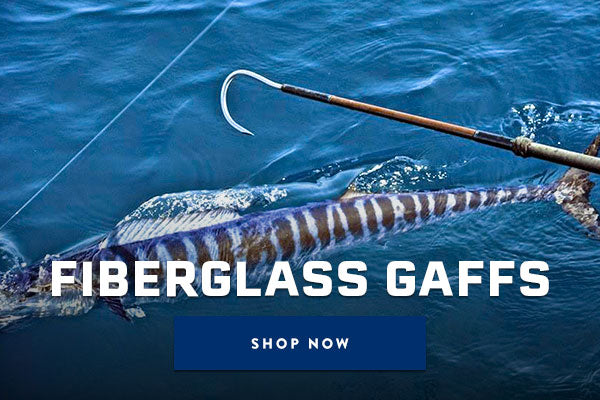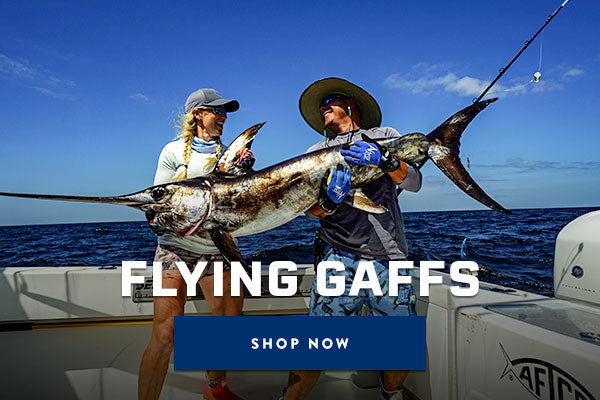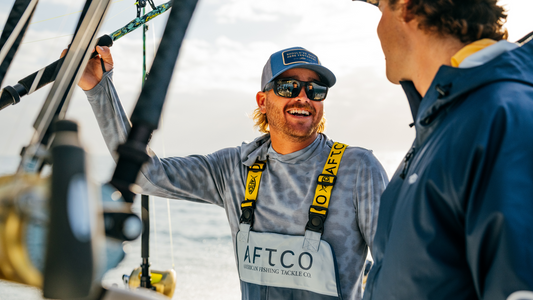
How To Select the Right AFTCO Gaff
AFTCO manufactures 33 different sizes of aluminum and fiberglass fixed-head and flying gaffs. How do you determine the handle length, hook size and best material for your application?
Gaff Length
Gaff length is normally determined by the size and gunnel height of the vessel where the gaff will be used. Anglers fishing from small skiffs and kayaks can usually get away with gaffs measuring 2’ to 4’ in length due to their close proximity to the water. Longer gaffs are tougher to store and handle on smaller skiffs and kayaks, and the gaffing of most fish all takes place close at hand.
On medium sized skiffs and boats from 18’ to 30’ AFTCO recommends gaffs from 4’ to 6’ in length. In most cases, a gaff of 6’ is just about ideal for most all applications gaffing smaller tuna, dorado (also known as mahi mahi), halibut, bass, snappers, etc. Some people like to have a 4’ gaff as a back-up or lifting gaff to be used on bigger fish over 50lbs after the initial 6’ gaff has been placed to control the fish and bring alongside the boat. AFTCO’s most popular selling gaff is a 4’ with 3” hook, like the 354 or 354L.
Fishing boats measuring 30’ to 50’ and above should only need gaffs measuring 6’ to 8’ in length. This allows fish to be easily gaffed from the lower stern area and up in the bow where the gunnel is higher off the water. You can always choke up on a longer 8’ gaff if the need arises, but you can’t make a 6’ gaff reach the water if you must gaff from the bow on a larger vessel!
Hook Size
Gaff hook size is usually determined by the size and shape of the fish being most commonly gaffed. In general, fish under 50lbs only need a gaff hook with gap measuring 2” to 3” to be effective, but on some species such as dorado, king mackerel, barracuda and other slim-bodied species, a 2” hook is almost always the best choice. Fish weighing over 50lbs should almost always be gaffed using a 3” or 4” hook. This allows a bigger bite into the body of the fish and will result in less fish tearing off the hook. On some species such as sharks, large tuna and jumbo cobia, 4” or even our biggest 5” GFA586 gaff should be used. This is due to the soft flesh and tremendous power of cobia and tuna. Sharks have tougher flesh but are notorious for twisting and thrashing their way off the gaff at boat-side.
Handle Material
AFTCO makes fixed-head gaff handles in both swaged aluminum and super-strong epoxy fiberglass. AFTCO’s anodized aluminum gold or black gaffs are iconic on boats in marinas around the world. For almost 40 years they have been the top choice of the best captains and boat owners, and has been our best fishing gaff in terms of units sold. The AFTCO swaged aluminum handles are extremely durable, strong and effective. The AFTCO fiberglass fixed head gaffs are also tapered like the swaged aluminum models, and they come in the most popular 4’, 6’ and 8’ lengths with the popular 2’, 3’ and 4’ hook sizes. Many crews prefer the super-strong epoxy fiberglass handles due to their 20% lighter weight and extreme flexibility. They also feature tuna-cord wrapped handles with Turk’s Head knots which are extremely easy to grip with wet or slimy hands.
Flying Gaffs
AFTCO flying gaffs are available in 4", 5”, 6”, 8”, 10” and 13” hook sizes. The 6’ gaff fits the 5”-13” hooks while the 8’ gaff fits the 4” hook. All are designed to comply with the 8’ IGFA-designated maximum length when the hooks are attached. In general, a flying gaff should only be used on tuna, billfish and large sharks weighing over 200lbs. Hook sizes should be selected to be approximately ⅓ to ½ the width of the maximum body diameter of the fish to be flying gaffed. In other words, if the body of the swordfish, tuna, etc. being gaffed is about 2’ in diameter at the shoulder where the gaff should be placed, the ideal gaff size would probably be 8” to 10”. This allows the gaff to get the maximum bite into the fish, while at the same time penetrating the backbone and vitals to quickly control and dispatch the catch.
All the above recommendations are general guidelines and may not apply in every circumstance or situation encountered on the water. All anglers and crew should exercise extreme care and caution whenever gaffing, landing or handling large game fish at boat side.









